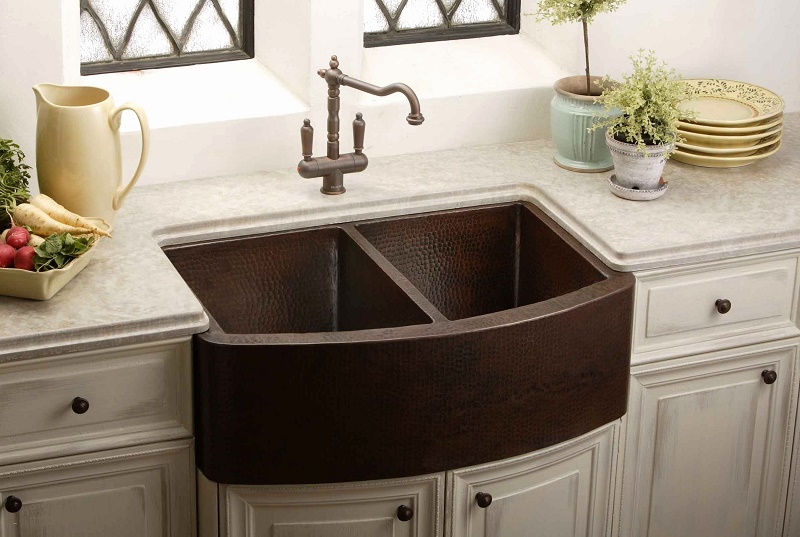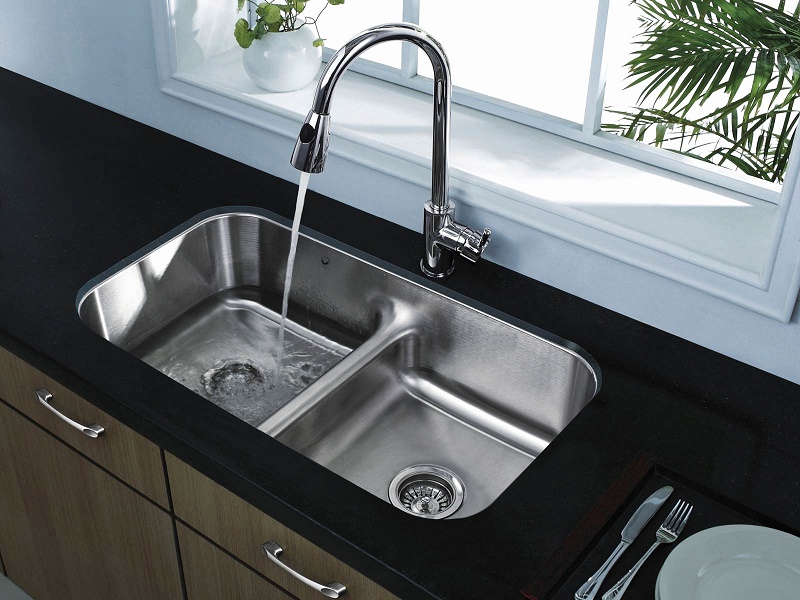
How many times each day do you use the sink in your kitchen? Are you facing unclog a kitchen sink and bathroom sink? If yes, you are in the right place. The kitchen sink is indispensable to your daily routine, but you do not appreciate it until something goes wrong.
A clogged sink is often a disaster, as the dishes accumulate and cooking stops until the drain is clean. If your kitchen sink clogged now, follow the steps below how to unclog a sink. And make the stove work again without harmful chemicals.
How to unclog kitchen sink?

Have you ever had a sink that did not work properly? Basin sinks are usually slow due to the accumulation of hair and other debris in the drainage assembly. To unclog a slow drain, fill the sink with approximately 2 liters of water.
Use a cleaning cloth or paper towel to cover the overflow opening near the top of the sink. Now place a cup plunger over the drain and push down and pull up until the obstruction is cleared. Be sure to use a cup plunger and not a flange plunger for toilets.
Cleaning a slow draining tub is very similar to the sink. First, remove the strainer in the drain of the bathtub and remove all the hair and the accumulation that may have. Again, the best plunger for this is the plunger of the cup.
Second, remove the trigger lever; This is the lever that is just above the drain that you use when you want to take a bath. Take a washcloth or paper towel and cover the opening.
Fill the tub with a few inches of water. Take the plunger with one hand and cover the drain with the other hand. Move the plunger up and down hard to eliminate drainage. Repeat these steps several times until the drain runs out.
Keep in mind that most clogged drains come from the accumulation of hair and soap. There are several different types of filters that you could use that would help prevent.
Causes of unclogging the sink

Old pipes, drain pipes are manufactured with long-lasting polymers (polymer is the nice way to say plastic). If your house is about 50 years old or more you should keep in mind that the pipes have aged with it. The plastic used is PVC, and over the years it tends to form roughness on its walls. This roughness increases the contact force between the internal walls of the pipe and the remains of soap or toothpaste.
Seated residues, pieces of toothpaste, residues of foam and soap, including mouthwash. All these products leave residues that adhere to the internal walls of the pipes. Consequently, new residues adhere to the old to form a plug.
Make a solution for drainage and cleaning. Combine 1/3 cup of baking soda with 1/3 cup of vinegar in a large measuring cup, carafe or bowl. The solution will increase rapidly when you combine the ingredients. So, make sure the container is large enough to leave enough space at the top.
Pour the solution down the drain. Quickly pour all the contents of the container down the drain. The faster this can be achieved, the better. The bubbling action will gradually disappear.

• Wait 5 minutes. Give time to solutions to eliminate drainage.
• Rinse with warm water. Turn on the tap and rinse the solution with warm or hot water. The obstruction should disappear, and the water should be wasted normally.
If this does not work the first time, try it a couple more times. Also, try to rinse it with a pot of boiling water. Sometimes, the boiling water will dissolve the blockage while it is in the drain.
Remove all the water from your sink before attempting this. The solution will not go down the drain with all its power. If the influences of the water sink, remove it with a cup or bowl.
A better way to get the water out of the sink is to use a short hose or a rubber tube to extract the water from the sink. Put one end in the water and the other in a bucket or pot on the floor.
If you suck the lower end of the hose, water will begin to flow through it. The water will continue to flow after you stop sucking. Initially, it must flow uphill to get out of the sink.
Just make sure you keep your mouth away before the water reaches your end of the hose. This method allows you to draw water even from the depths of the pipe, and it is much faster than using a container.
If the vinegar/baking soda/boiling water does not work, fill the sink with water. When you have a double sink, place the stopper in the non-disposable sink.
Activate the elimination, remove the plug and many times the elimination will generate pressure on the elimination water to the point. It will dislodge the obstruction.
Clearing a clogged sink

At some point in the life of your pipes and fittings, you will have to deal with a sink that drains slower than normal; sometimes it does not even drain.
If this problem only happens to a certain receiver, then it has a blocked receiver. Compared to a clogged sewer, it is easier to clean a sink drain. Continue reading this article to see how to do it yourself.
Let’s start with the simplest way to unclog the sink: boiling water. Although this is only effective if you have metal pipes, pouring boiling water directly down the drain can dissolve the blockage and clear the drain pipe.
Boil about a gallon of hot water in a large teapot or use a teapot. Pour the water directly into the drain and not into the porcelain. Never use hot water to unclog a sink if you have PVC pipes since hot water can soften these pipes, which causes the joints to loosen.
When the boiling water was not able to help or if you have PVC drain pipes, you need to use a plunger to fix a clogged sink. First of all, you should know that there are two types of pistons, then the piston of the cup and the piston of the flange.
To unclog a sink, you must use a cup plunger. The flange plunger should be used in toilets because they are specifically designed for it. For hygienic reasons, you do not want to mix the two.

When you have the right plunger, seal the overflow outlet of the sink with a piece of tape. The overflow of the sink is located on the top of most sinks.
For a kitchen sink, remove the basket strainer if you have one. You also need to remove the drain plug in a sink. After doing this, fill the sink half full with water. Next, try to clear your drain pipe with fast, clear dives. However, be careful not to break the sink.
If even the plunger fails, it’s time for the auger. To work in a sink, use a sink auger or a container auger, sometimes also called a drum auger.
With the drain plug or basket removed, insert the auger cable into the drain. Continue to extend the cable until you feel it against the obstruction and then extend about twelve inches more. Tighten the adjustment screw and turn the auger crank.
Use firm but gentle pressure. When you feel the clog clears, spread more rope until you have passed through the blockade. Repeat this a few times and rinse with hot water when the water begins to flow down the drain. You can also use a plumbing snake instead of the auger.
The use of the drill generally clears most obstructions. However, a clogged sink can be severely blocked. So that, you may need the help of professional plumbers.
When all else fails, it’s time to look in the phone book and look for plumbing companies. Many reputable companies offer plumbing services at very affordable prices. They can also help you with other problems that are not a clogged sink.
What is good to unclog the kitchen sink?

It is always unpleasant to discover a clogged drain. Fortunately, there are several methods available that you can try before you have to pick up the phone and contact your local plumber.
The first thing to do is run very hot water down the drain for 5-10 minutes. Sometimes, this is all you need to break whatever is obstructing your sink. Look at the sink, if it is filling quickly and does not fall, turn off the water and try a different method.
If hot water did not work and you now have a sink full of water, you can take a plunger to your sink. If you do not have one, quickly go to your local hardware store and buy one. They only cost between 3 and 5 Euros. Be sure to choose one that has a wooden handle, and that is made of rubber, anything else will be ineffective. While in the store, you can also buy a bottle of Draino.
If the plunger did not unclog the sink, then the clogged drain may be caused by material in the sink trap. The sink trap is the curved pipe under your sink.
If you hesitate to open the sink trap, you can try using the Draino. Be sure to follow the instructions carefully. There is a good chance that this works. If it does not, then you must open the sink trap to eliminate the blockage.
To clean the sink trap:
Place a bucket under the sink trap to trap the water in the clogged sink. If the sink is too full, you may want to remove it first with the bucket.

Take a Phillips screwdriver and unscrew all the screws that hold the kitchen trap in place.
Now, take the pipe and slowly and carefully pull it down to remove the trap.
With a bottle brush, clean the inside of the pipe and remove all dirt. This will help reduce the accumulation in the future. Then, wrap the silicone tape, which is also called plumbing tape around the threads of the pipe.
When replacing the trap in its place, be sure to tighten the screws well to avoid jumping the next time you turn on the water. Run hot water through the pipes to remove excess dirt and grime, then test the sink. If you followed the instructions above, you would no longer have a blocked drain.
You may also like Keeping the Heat out of the Kitchen

